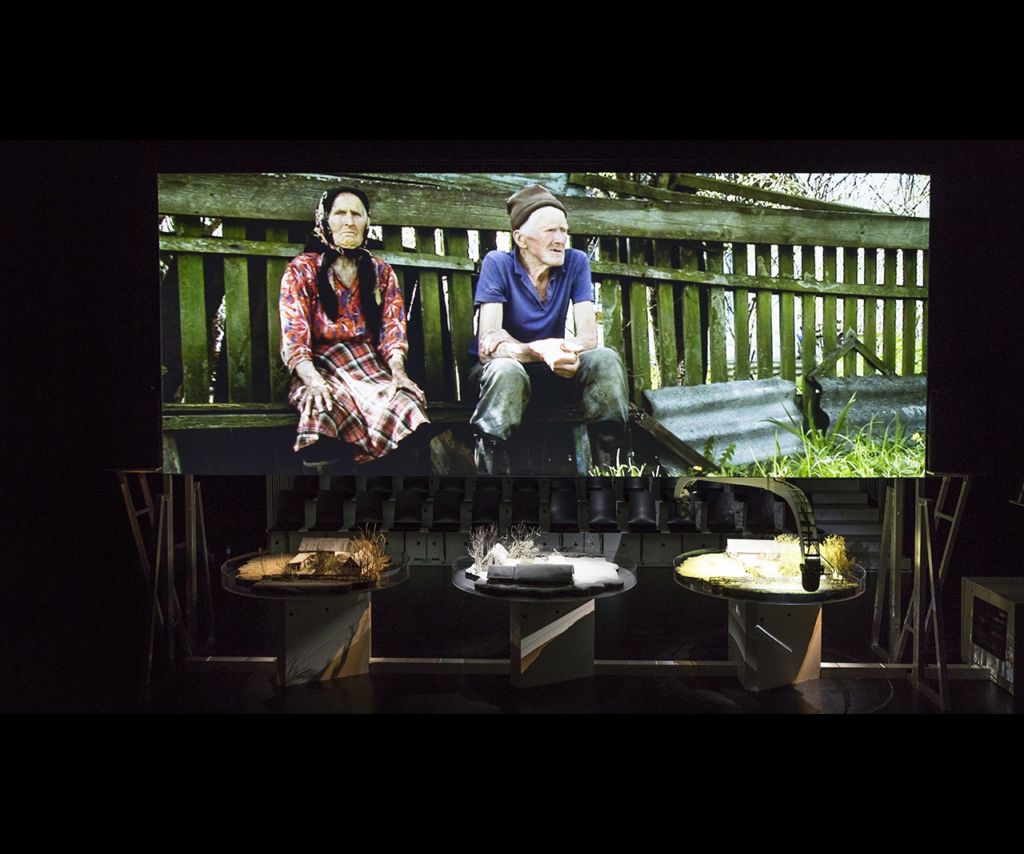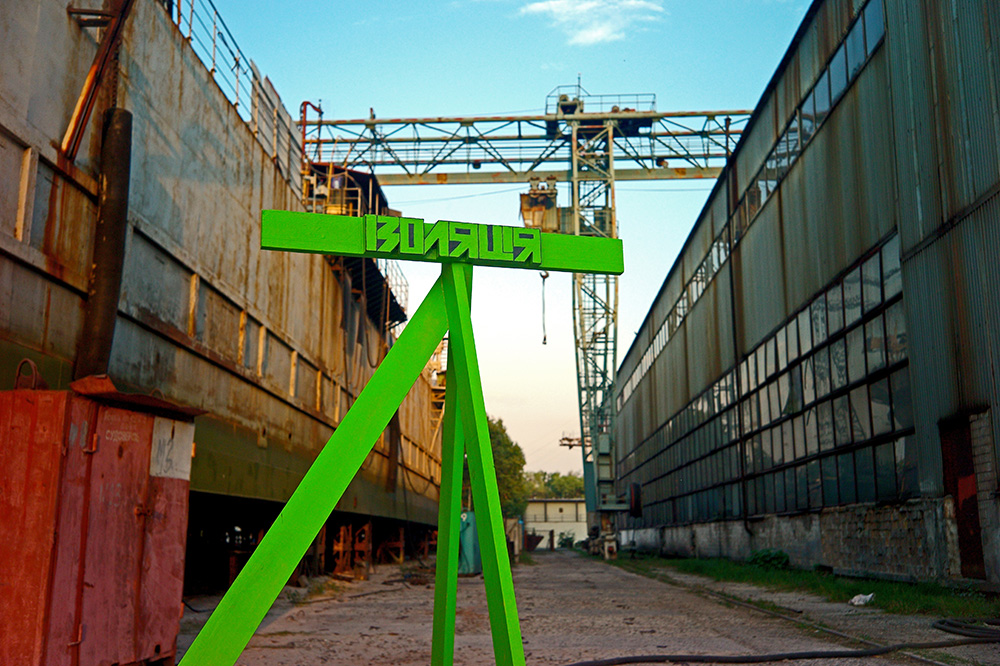While the recent upswing in tourism to Chernobyl, sparked by the eponymous series broadcasted on American TV-channel HBO, sometimes borders on indecency, the piece Zvizdal by the Belgian collective Berlin offers a humble portrait of the last two remaining inhabitants in a village that turned ghost town following the nuclear disaster.
The Belgian collective Berlin was founded in 2003 by Bart Baele and Yves Degryse. Every theater piece they make is tied to a specific city or region, yet always involves their characteristic documentary and interdisciplinary approach, reflected on stage through the use of video.
Zvizdal is the result of five years of filming in the village of the same name. From 2011 to 2016, a team made up of Bart Baele, Yves Degryse and Cathy Blisson —French journalist, dramaturge and writer specialized in hybrid artistic projects that straddle performing and visual arts—regularly went to visit the elderly couple Pétro and Nadia in Zvizdal to film their day-to-day. The couple was nearly 90 years old at that time, which means they were about 60 when the explosion occurred—the advanced aging of their cells most likely explains why the effects of radiation have remained invisible on them.
Zvizdal is the final show in the “Holocene” series, named after the geological epoch that spans the past ten thousand years, although some scientists now refer to the “Anthropocene” to describe the past three centuries marked by human activity. It acts as a transition to the next series, “Horror Vacui”—fear of emptiness. The film is an attempt to accept and appropriate this supposed emptiness.
All of the villages within a 30-kilometer radius of Pripyat—a city located 3 kilometers from the nuclear site and created in 1970 to house the plant’s employees—were evacuated in 1986. The solitude of this place comes through in the elderly couple’s monologues, their endless waiting, their joy at the sight of a car driving past—the closest populated area is about twenty kilometers away. This solitude is made even more palpable through the stage concept, which is void of any human presence. There are no actors: Pétro and Nadia speak to the public unmediated, aside from the digital aspect of projecting the documentary. One screen and three mobile stages with scaled models of their home during three different seasons: autumn, winter and summer. The spectator enters this site, evacuated in 1986, by way of two cameras: one that films Nadia and Pétro, and another one, mobile, that zooms onto screens placed throughout the set, sweeping across plastic figurines of a cow, a dog, a tree, a man and a woman.
The set-up for recording and transmitting the couple’s daily life is in stark contrast with the actual daily life in question. Pétro and Nadia are isolated, without electricity, heat or running water, no Internet or other technology. They live in a zone where nature has reclaimed the abandoned houses—the lushness of the vegetation is surprising, it hardly corresponds with the image one might have of ground zero. And yet technology, usually absent from their routine, is what infiltrates their home and re-broadcasts images to the public. The subtitle “Chernobyl—so far so close” emphasizes this feeling that only the camera has been grated access to the couple, their village and their home, as if nothing but “vacuum technology”—the term for physical technologies required to produce, regulate and measure emptiness—could survive such nuclear silence. Most images from the zone have actually, until recently, been recorded by drones, like those by American filmmaker Philip Grossman in the documentary Lost City of Chernobyl (2015) about the nuclear exclusion zone, or those by British director Danny Cooke of an abandoned playground, children’s toys and gas masks left astray for his short film Postcards From Chernobyl (2014), as well as those used for the post-apocalyptic film sets created by Scottish director Colm McCarthy, in the adaptation of British author M. R Carey’s eponymous novel, The Girl with All the Gifts (2016). Wherever the drone shows the disappearance of life, Berlin’s cameras reinfuses it.
Berlin’s choice to reproduce the consequences of faulty technology—it was the unmonitored increase in one reactor’s pressure that led to the entire plant exploding—through a stage concept that combines various technical and digital recording and broadcasting techniques, accentuates the media’s silence surrounding the event and which continues to surround the “un-displaced”. A silence that translates first and foremost into an illusion, or perhaps a denial, of the catastrophe, like in France, where media outlets reported the radioactive cloud would not pass through the ‘Hexagon’. Even today, we still cannot measure the true impact of this radiation and have no idea whether the nuclear exclusion zone might one day become habitable again. According to historian Galia Ackerman, the area will not be completely rid of plutonium 239 residue, one of the toxic radioactive substances, for another 240 000 years. Nearly 250 000 people were displaced or relocated outside of this zone immediately following the accident, such as Pétro and Nadia’s daughter and neighbors, who appear only briefly in the film. Nadia and Pétro were also amongst them at first, but they decided to return, determined to stay in their native village despite the ban, the health risks and completely destitute isolation. There are about a thousand people who have returned in this way. They are nicknamed “samosely” (self-settlers). Their struggle is one of the earth, the hearth, a refusal to be displaced that echoes the situation of refugees throughout the world and is a reminder of the uprooting and loss that accompanies migration and other forced displacements resulting from conflicts, natural catastrophes or expropriations. The documentary White Horse (2008) by American filmmaker Maryann DeLeo and French artist Christophe Bisson films the return of Maxym Surkov, a Ukranian evacuated from Pripyat in 1986, to his home village. A calendar from the year 1986 is still attached to the wall in his childhood apartment, and he rips out almost every page, or at least everything after April 26, the day after which “this place ceases to exist”.
Translation by Maya Dalinsky
Cover : ZVIZDAL, 2019, © FREDERIK BUYCKX









